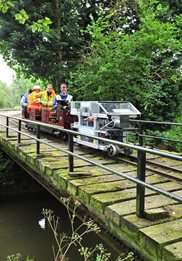Engineering students build UK's first hydrogen powered locomotive

Engineering students and staff at the University of Birmingham have designed and built a prototype hydrogen powered locomotive, the first of its kind to operate in the UK.
This narrow gauge locomotive is a hybrid design, combining a hydrogen fuel cell and lead acid batteries similar to the ones used in cars. The fuel cell is used both to power the permanent magnet electric motors and to charge the batteries, with the batteries helping to meet the peak power demands when accelerating under load.
Hydrogen provides a clean source of energy and it offers a considerable extension in range in comparison to battery only operation. Over 5 000 litres of hydrogen are stored in a solid state metal hydride tank at relatively low pressure, with the system typically operating at just 5 bar. This was achieved by using one of the ten advanced hydrogen storage units successfully employed on the University’s hydrogen powered canal boat, the Ross Barlow.
This amount of hydrogen would enable the locomotive to haul a 400 kg load up over 2 700 m, twice the height of Ben Nevis, and two additional tanks can be easily fitted to further extend its range.
The locomotive also features regenerative braking to capture, store and re-use braking energy, as well as adjustable air suspension and a highly advanced touchscreen remote control that operates over a Wi-Fi link.
The locomotive was tested at the Stapleford Miniature Railway in Leicestershire as part of a competition led by the Institute of Mechanical Engineering. Stephen Kent the Team Leader, said: ‘We are really pleased with the locomotive, particularly as it managed to haul 4000kg, well over 6 times the specified load.’
Provided by University of Birmingham



















